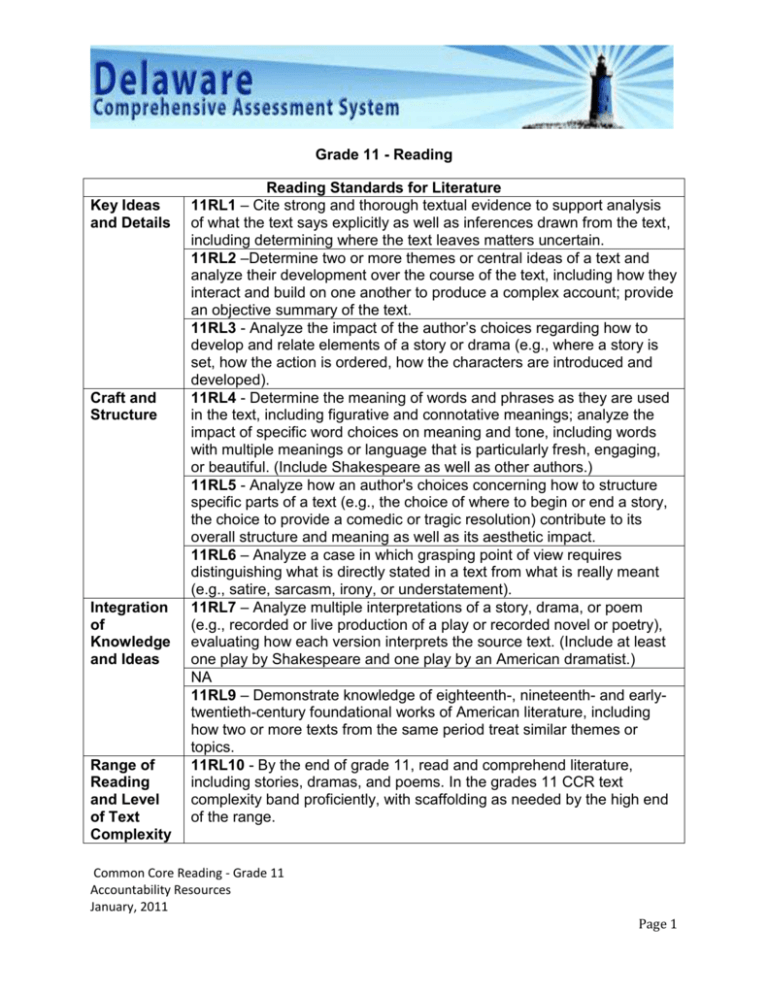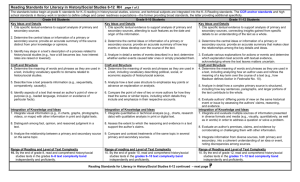Grade 11
advertisement

Grade 11 - Reading Key Ideas and Details Craft and Structure Integration of Knowledge and Ideas Range of Reading and Level of Text Complexity Reading Standards for Literature 11RL1 – Cite strong and thorough textual evidence to support analysis of what the text says explicitly as well as inferences drawn from the text, including determining where the text leaves matters uncertain. 11RL2 –Determine two or more themes or central ideas of a text and analyze their development over the course of the text, including how they interact and build on one another to produce a complex account; provide an objective summary of the text. 11RL3 - Analyze the impact of the author’s choices regarding how to develop and relate elements of a story or drama (e.g., where a story is set, how the action is ordered, how the characters are introduced and developed). 11RL4 - Determine the meaning of words and phrases as they are used in the text, including figurative and connotative meanings; analyze the impact of specific word choices on meaning and tone, including words with multiple meanings or language that is particularly fresh, engaging, or beautiful. (Include Shakespeare as well as other authors.) 11RL5 - Analyze how an author's choices concerning how to structure specific parts of a text (e.g., the choice of where to begin or end a story, the choice to provide a comedic or tragic resolution) contribute to its overall structure and meaning as well as its aesthetic impact. 11RL6 – Analyze a case in which grasping point of view requires distinguishing what is directly stated in a text from what is really meant (e.g., satire, sarcasm, irony, or understatement). 11RL7 – Analyze multiple interpretations of a story, drama, or poem (e.g., recorded or live production of a play or recorded novel or poetry), evaluating how each version interprets the source text. (Include at least one play by Shakespeare and one play by an American dramatist.) NA 11RL9 – Demonstrate knowledge of eighteenth-, nineteenth- and earlytwentieth-century foundational works of American literature, including how two or more texts from the same period treat similar themes or topics. 11RL10 - By the end of grade 11, read and comprehend literature, including stories, dramas, and poems. In the grades 11 CCR text complexity band proficiently, with scaffolding as needed by the high end of the range. Common Core Reading - Grade 11 Accountability Resources January, 2011 Page 1 Key Ideas and Details Craft and Structure Integration of Knowledge and Ideas Range of Reading and Level of Text Complexity Reading Standards for Informational Text 11RI1 - Cite strong and thorough textual evidence to support analysis of what the text says explicitly as well as inferences drawn from the text, including determining where the text leaves matters uncertain. 11RI2 – Determine two or more central ideas of a text and analyze their development over the course of the text, including how they interact and build on one another to provide a complex analysis; provide an objective summary of the text. 11RI3 – Analyze a complex set of ideas or sequence of events and explain how specific individuals, ideas, or events interact and develop over the course of the text. 11RI4 – Determine the meaning of words or phrases as they are used in text, including figurative, connotative, and technical meanings; analyze how an author uses and refines the meaning of a key term or terms over the course of a text (e.g., how Madison defines faction in Federalist No. 10). 11RI5 – Analyze and evaluate the effectiveness of the structure an author uses in his or her exposition or argument, including whether the structure makes points clear, convincing, and engaging. 11RI6 – Determine an author’s point of view or purpose in a text in which the rhetoric is particularly effective, analyzing how style and content contribute to the power, persuasiveness, or beauty of the text. 11RI7 – Integrate and evaluate multiple sources of information presented in different media or formats (e.g., visually, quantitatively) as well as in words in order to address a question or solve a problem. 11RI8 – Delineate and evaluate the reasoning in seminal U.S. texts, including the application of constitutional principles and use of legal reasoning (e.g., in U.S. Supreme Court majority opinions and dissents) and the premises, purposes, and arguments in works of public advocacy (e.g., The Federalist, presidential addresses). 11RI9 – Analyze seventeenth-, eighteenth-, and nineteenth-century foundational U.S. documents of historical and literary significance (including The Declaration of Independence, the Preamble to the Constitution, the Bill of Rights, and Lincoln’s Second Inaugural Address) for their themes, purposes, and rhetorical features. 11RI10 - By the end of grade 11, read and comprehend literary nonfiction in grade 11 CCR text complexity band proficiently, with scaffolding as needed at the high end of the range. Common Core Reading - Grade 11 Accountability Resources January, 2011 Page 2 Reading Standards for Literacy in History/Social Studies 11-12RH/SS1 – Cite specific textual evidence to support analysis of primary and secondary sources, connecting insights gained from specific details to an understanding of the text as a whole. 11-12RH/SS2 – Determine the central ideas or information of a primary or secondary source; provide an accurate summary that makes clear the relationships among the key details and ideas. 11-12RH/SS3 – Evaluate various explanations for actions or events and determine which explanation best accords with textual evidence, acknowledging where the text leaves matters uncertain. Craft and 11-12RH/SS4 – Determine the meaning of words and phrases as they Structure are used in a text, including analyzing how an author uses and refines the meaning of a key term over the course of a text (e.g., how Madison defines faction in Federalist No. 10) 11-1 RH/SS5 – Analyze in detail how a complex primary source is structured, including how key sentences, paragraphs, and larger portions of the text contribute to the whole. 11-12RH/SS6 – Evaluate authors’ differing points of view on the same historical event or issue by assessing the authors’ claims, reasoning, and evidence. Integration 11-12RH/SS7 – Integrate and evaluate multiple sources of information of presented in diverse formats and media (e.g., visually, quantitatively, as Knowledge well as in words) in order to address a question or solve a problem. and Ideas 11-12RH/SS8 – Evaluate an author’s premises, claims, and evidence by corroborating or challenging them with other information. 11-12RH/SS9 – Integrate information from diverse sources, both primary and secondary, into a coherent understanding of an idea or event, noting discrepancies among sources. Range of 11-12 RH/SS10 - By the end of grade 11, read and comprehend Reading history/social studies texts in the grade 11 text. and Level of Text Complexity Key Ideas and Details Common Core Reading - Grade 11 Accountability Resources January, 2011 Page 3 Reading Standards for Literacy in Science and Technical Subjects Key Ideas 11-12RS/TS1 – Cite specific textual evidence to support analysis of and Details science and technical texts, attending to important distinctions the author makes and to any gaps or inconsistencies in the account. 11-12RS/TS2 – Determine the central ideas or conclusions of a text; summarize complex concepts, processes, or information presented in a text by paraphrasing them in simpler but still accurate terms. 11-12RS/TS3 – Follow precisely a complex multistep procedure when carrying out experiments, taking measurements, or performing technical tasks; analyze the specific results based on explanations in the text. Craft and 11-12RS/TS4 – Determine the symbols, key terms, and other domainStructure specific words and phrases as they are used in a specific scientific or technical context relevant to grades 11-12 texts and topics. 11-12RS/TS5 – Analyze how the text structures information or ideas into categories or hierarchies, demonstrating understanding of the information or ideas. 11-12RS/TS6 – Analyze the author’s purpose in providing an explanation, describing a procedure, or discussing an experiment in a text, identifying important issues that remain unresolved. Integration 11-12RS/TS7 –Integrate and evaluate multiple sources of information of presented in diverse formats and media (e.g., quantitative data, video, Knowledge multimedia) in order to address a question or solve a problem. and Ideas 11-12RS/TS8 – Evaluate the hypotheses, data, analysis, and conclusions in a science or technical text, verifying the data when possible and corroborating or challenging conclusions with other sources of information. 11-12RS/TS9 – Synthesize information from a range of sources (e.g., texts, experiments, simulations) into a coherent understanding of a process, phenomenon, or concept, resolving conflicting information when possible. Range of 11-12RS/TS10 - By the end of grade 11, read and comprehend Reading science/technical texts in the grade 11 text. and Level of Text Complexity Common Core Reading - Grade 11 Accountability Resources January, 2011 Page 4











